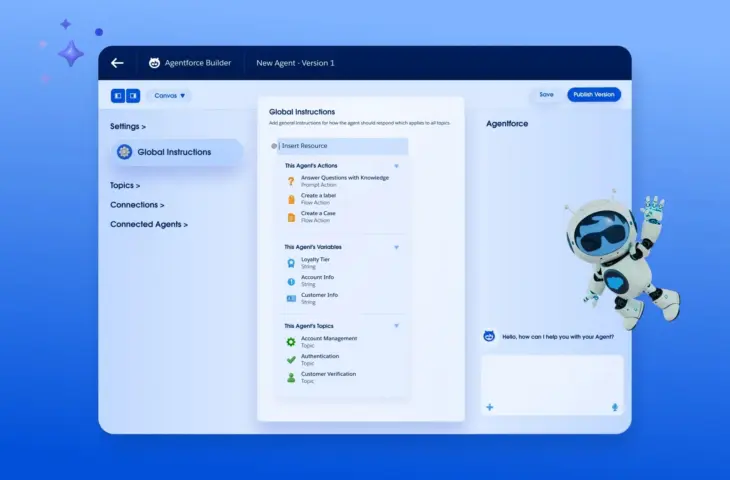Salesforce launches Agentforce 360 at its annual Dreamforce conference in San Francisco. Under this banner, the CRM specialist combines its AI-related services into one platform.
It’s been a year since Salesforce launched Agentforce at Dreamforce. Agentforce was then a platform for integrating AI agents within the business environment. Today, just over a year later, Salesforce introduces Agentforce 360 at a new Dreamforce.
Version Jumps
This doesn’t mean that Agentforce got a new version number every day since last year, but it came close. After Agentforce 2, 2dx and 3, Salesforce is now launching Agentforce 360, which is meant to convey ubiquity.
However, Agentforce is still a platform for integrating AI agents within the business environment, just as it was in the beginning. Since the launch, Salesforce has incrementally improved the platform. For instance, the underlying Atlas reasoning engine has been enhanced, more workflow integration was added, and Salesforce improved interoperability and management this summer.
Four Pillars
For Agentforce 360, Salesforce builds on four pillars:
- The Agentforce 360 platform itself: this encompasses the basic capabilities to build and deploy AI agents, including from an AI-driven development environment.
- Data 360: this is the data layer. Here Salesforce connects the data that the AI agents work with. Think of it as a rebranding of the data cloud in AI context, but also more than that. Salesforce offers a consistent data model with Tableau Semantics and collaborates with partners including Databricks and Snowflake.
- Customer 360 apps: Salesforce has been grouping its application offerings under Customer 360 for several years. The company wants to indicate that it has outgrown CRM and can support entire business operations with its portfolio. Salesforce integrates conversational agents into all its apps, including Marketing, Service, and Commerce.
- Slack: Salesforce has previously called Slack the digital headquarters. The company sees the communication tool as a hub that serves as an interface for conversations between people, as well as between people, data, and AI.
Integration vs. Marketing Story
Agentforce 360 is both a major step and a pure marketing story. On one hand, Salesforce is launching an important platform here. Many companies are interested in AI, but not in costly and complex implementations. Salesforce connects everything that needs to be connected to optimally deploy AI within the platform.
read also
Salesforce Introduces Agentforce 360: Broader Variation on the Same Theme
This is added value for customers who are already deeply embedded in the Salesforce ecosystem. They can now unleash autonomous AI agents on their data simply by describing what they want in an AI-driven development tool (if it works as promised).
On the other hand, Salesforce is building further on what it has already developed over the past year (and many years before with Einstein). The promise of Agentforce 360 is actually the same as that of Agentforce (1.0) last year. A year of maturity has resulted in more integrations within Salesforce and given the marketing department time to neatly package the result.
Concrete Innovation
There are some real innovations in this latest update of Agentforce. For example, there’s Agent Script, which allows users to better optimize AI agents for ‘if/then’ scenarios. This contributes to the predictability of agents when they need to function within a rigid framework. This feature comes to market in November.

Agentforce Builder is also scheduled for November and allows you to build and deploy agents in natural language without additional configuration. This tool builds on Agent Builder and the recently introduced Agentforce Vibes.
Salesforce certainly believes in the power of AI agents, and we’ve also heard from customers that the simple and integrated implementation is appreciated. Salesforce continues to build on this with Agentforce 360: AI agents are now ubiquitous.
